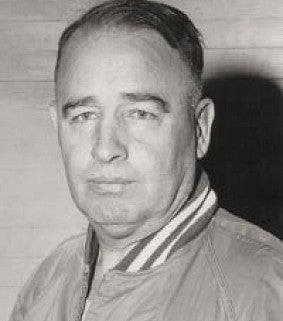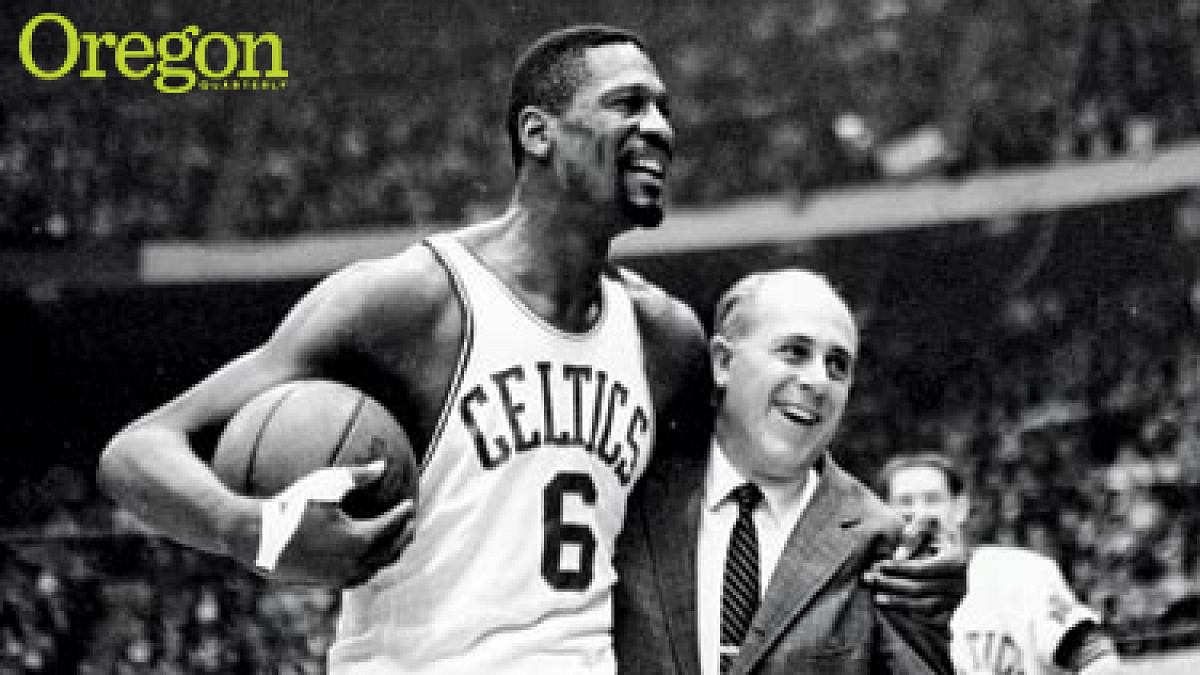Bob Reinhart ’52 had a story to tell. It was, Bob believed, the untold tale of a largely forgotten college coach who was the father of basketball’s fast-break offense.
The story was to be about Bob’s uncle, Bill Reinhart ’22. Raised in Salem, the UO grad had coached basketball, baseball, and football at the UO from 1923 to 1935, and then gone on to coach the same three sports for another twenty-four years at George Washington University. In both places, Bill Reinhart energized basketball and built solid winning records, earning him recognition in Oregon’s Sports Hall of Fame and George Washington’s Athletic Hall of Fame.
The legendary coaching success of “Red” Auerbach, one of Reinhart’s players at George Washington, would give the nephew’s story the punch it needed to attract broad interest. Bill Reinhart had recruited Auerbach, a Brooklyn junior college student, to George Washington. Auerbach went on to coach the Boston Celtics to nine National Basketball Association championships, and he never stopped giving Reinhart credit for teaching him the basics of the fast break, a key to his team’s success.
William Jennings Bryan Reinhart, who died February 14, 1971, at age seventy-four, was never recognized by the Naismith Memorial Basketball Hall of Fame in Springfield, Massachusetts, much to the dismay of his nephew and of Auerbach. “By the time people got around to nominating him he was more of a forgotten kind of guy,” said Ed McKee, George Washington’s director of athletic development.
Bob Reinhart wanted to correct what he considered history’s snub of a coach who, he’d written to the Hall of Fame in 1994, “invented basketball’s fast break and transition defense.” Bob grew up in Portland and attended the UO on a journalism scholarship. He’d worked in the men’s clothing industry and for five years lived in Maryland, sometimes attending George Washington games coached by his uncle.
He suffered a severe stroke in 1979, when he was only forty-nine years old, losing the full use of his left leg and arm. “It changed his life totally,” says his wife, Mary Jeanne, of Sherwood.
Around that time Bob started talking about writing his uncle’s story. Slowly, he gathered materials: newspaper clippings, archival documents from Bill’s high school and the colleges where he’d coached, and letters from the coach’s former players.
Using a typewriter or writing by hand, Bob crafted numerous versions of introductory chapters and produced a table of contents for the unwritten book. He even designed a cover page depicting a basketball aloft above the old Salem High School.
The stories and approaches changed, but never the title: Fast Break Hoops.
But his dream was not to be. Bob’s declining health slowed his progress, and he died in June 2009. As he approached death, he was anguished over a job left unfinished.
“He couldn’t believe it,” says Mary Jeanne. “He was so angry.”
* * *

At the UO, Bill Reinhart was quarterback on the 1920 Rose Bowl team that lost to Harvard 7–6. Not long after graduating in 1922 in business administration, Bill returned to the UO as a sports teacher and coach.
He soon got his big coaching break, according to Howard “Hobby” Hobson ’26, who played for Reinhart and would later succeed him as coach. With the 1923–24 season approaching and without a coach, the basketball team was asked to recommend either Reinhart or an outside “name” coach, Hobson later wrote in Shooting Ducks, his history of UO basketball. Although Reinhart had only “dubious credentials,” he won the team’s support and landed the job, Hobson recounts.
Quickly earning a reputation as a taskmaster, Reinhart produced three championship teams in four years. As its name transitioned from the Lemon-Yellows to the Webfoots, the team generated so much excitement that UO students in 1926–27 voted to pay the $185,000 cost of a new arena—Mac Court—to replace an old armory as the team’s home court.
“The students indebted themselves and paid off the thing in three years—all because Reinhart was up to date on how to play basketball,” says Keith Richard, University archivist emeritus.
Reinhart left Oregon in 1935, having achieved a basketball record of somewhere near 180 wins and 101 losses over eleven seasons (sources vary), to take a three-sport coaching job at George Washington.
His time with the Colonials was sliced in two: from 1935 to 1942 and again from 1949 to 1966. In between, he served in the Navy and coached the Fleet City Blue Jackets football team, which won the national service championship in 1945. In this period he picked up a cigar-smoking habit that would later become a trademark. He then became athletic director-coach at the Merchant Marine Academy before returning to George Washington in 1949.
His basketball teams at George Washington achieved a 316–239 record and he won 524 games in the three sports he coached. His 1954 and 1961 basketball teams made it to the NCAA tournament, and the 1961 team was among the most memorable, dubbed “The Miracle of 1961” by one sportswriter. The Colonials finished a dismal seventh place in the nine-team Southern Conference, with a 3–9 season record. But in postseason play they stunned second-seeded Virginia Tech, then knocked off William and Mary to make it to the NCAA tournament, where they lost in the first round.
Reinhart’s most famous player-turned-coach, Red Auerbach, never stopped talking about the man who shaped his career.
“Red must have used his name a million times,” says Jack Kvancz, George Washington’s athletic director and a long-time friend of Auerbach, another trademark cigar smoker, who died in 2006. He always said that Reinhart deserved a place in the Hall of Fame, Kvancz says.
“I would never see his [Auerbach’s] eyes light up as much as when he talked about Reinhart,” he says.
Bob Reinhart’s files include a newspaper clip of a 1974 speech by Auerbach, then general manager of the Celtics, at Pacific University in Forest Grove. “Auerbach Says Bill Reinhart Was Best Basketball Brain,” the headline reads.
Bob Reinhart’s files also include two typed pages of what appear to be a more complete summary of Auerbach’s comments at Pacific University. The first sentence gets right to the point that Bob Reinhart hoped to make with Fast Break Hoops.
Auerbach says, “I don’t know who claims or is given credit for introducing the first organized fast break but I know who did it—Bill Reinhart.”
* * *
Probably the closest Bob Reinhart ever got to achieving his dream was when he floated his book idea to Bruce Taylor Hamilton, director of publications and special projects for the Oregon Historical Society, in 1993. There’s no copy of Reinhart’s original pitch, but on October 4 of that year Hamilton responded that he’d been expecting to hear again from Reinhart.
“For some reason, I thought I remembered you would be sending some additional material,” Hamilton wrote. He offered to provide direction but says he would only be willing to review a finished manuscript.
Reinhart answered a month later, providing new material and outlining a book not only about Reinhart but also about Slats Gill and Spec Keene.
“I appreciate the task before me, in transforming the facts and accomplishments of each man into a polished narrative, suitable for publication,” he wrote.
The file contains no further correspondence between the two men.
So perhaps it’s best to give Bob Reinhart the final word, with one of the introductions he wrote for the story he wanted to tell:
This book is a celebration of lessons in life not found in the classrooms, but on the hard wood floors, baseball diamond, and between the yard lines of football fields . . . the character and inner strength to assist us around, through, and beyond the rocks in the road of life.
It is the story of Bill Reinhart and how he played the game.
—By Gordon Oliver


